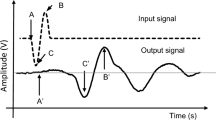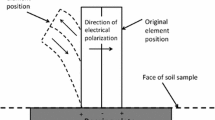Abstract
Bender element test setups have gained much popularity in the measurement of shear wave velocity (vs) in soil specimens, with the purpose of estimating the small strain shear modulus (Go). However the determination of shear wave arrival time from bender element tests can be subjective with results varying over a wide range, depending on the method adopted to identify the arrival time. This paper describes a series of bender element tests conducted on a pair of unconfined specimens, 38 mm in diameter and 76 mm in height, where the average data of the two are reported. With shear waves triggered at frequencies between 1 and 20 kHz, identification of the arrival time in both the time and frequency domains were performed. The different methods presented varying degrees of problems and discrepancies, with no one method emerging as a consistent winner. The time domain methods were apparently preferable due to its simplicity, which is perhaps one of the key factors contributing to the growing popularity of bender elements. The frequency domain methods, on the other hand, involved complex manipulation of the original signals, which can be onerous and time-consuming. Based on the findings, it was concluded that the reliability of shear wave velocity measurement with bender elements can be increased and the errors kept to a minimum, if the same arrival time identification method is performed with consistent judgment in a particular test series.






Similar content being viewed by others
References
Arroyo M (2001) Pulse tests in soil samples. Ph.D. Thesis, University of Bristol, UK
Arulnathan R, Boulanger RW, Riemer MF (1998) Analysis of bender element tests. ASTM Geotech Test J 21(2):120–131
Brignoli EGM, Marino G, Stokoe KHII (1996) Measurement of shear waves in laboratory specimens by means of piezoelectric transducers. ASTM Geotech Test J 29(4):384–397
Brocanelli D, Rinaldi V (1998) Measurement of low-strain material damping and wave velocity with bender elements in the frequency domain. Can Geotech J 35(6):1032–1040
Chan C-M (2006) Relationship between shear wave velocity and undrained shear strength of stabilised natural clays. In: Proceedings of the 2nd international conference on problematic soils. Kuala Lumpur, Malaysia, pp 117–124
Chan KH, Boonyatee T, Mitachi T (2010) Effect of bender element installation in clay samples. Géotechnique 60(4):287–291
Clayton CRI, Theron M, Best AI (2004) The measurement of vertical shear-wave velocity using side-mounted bender elements in the triaxial apparatus. Géoechnique 54(7):495–498
Dyvik R, Madshus C (1985) Lab measurements of Gmax using bender elements. In: Proceedings of the conference on the advances in the art of testing soil under cyclic conditions. ASCE Geotechnical Engineering Division, New York, pp 186–196
Fioravante V, Capoferri R (2001) On the use of multi-directional piezoelectric transducers in triaxial testing. ASTM Geotech Test J 24(3):243–255
Greening PD, Nash DFT (2004) Frequency domain determination of Go using bender elements. ASTM Geotech Test J 27(3):288–294
Greening PD, Nash DFT, Benahmed N, Ferreira C, Viana da Fonseca A (2003) Comparison of shear wave velocity measurements in different materials using time and frequency domain techniques. In: Proceedings of the 3rd international symposium on deformation characteristics of geomaterials. Lyon, France, pp 381–386
Jovičić V, Coop MR, Simic M (1996) Objective criteria for determining Gmax from bender element tests. Géotechnique 46(2):357–362
Kawaguchi T, Mitachi T, Shibuya S (2001). Evaluation of shear wave travel time in laboratory bender element test. In: Proceedings of the 15th international conference on soil mechanics and geotechnical engineering (ICSMGE), vol 1, pp 155–158
Lawrence FV (1963) Propagation of ultrasonic waves through sand. Research report R63–8. Massachusetts Institute of Technology, Cambridge
Lawrence FV (1965) Ultrasonic shear wave velocity in sand and clay. Research report R65–05, soil publication no. 175. Massachusetts Institute of Technology, Cambridge
Leong EC, Yeo SH, Rahardjo H (2005) Measuring shear wave velocity using bender elements. ASTM Geotech Test J 28(5):488–498
Leong EC, Cahyadi J, Rahardjo H (2009) Measuring shear and compression wave velocities of soil using bender-extender elements. Can Geotech Test J 46:792–812
Lings ML, Greening PD (2001) A novel bender/extender for soil testing. Géotechnique 51(8):713–717
Mattsson H, Larsson R, Holm G, Dannewitz N, Eriksson H (2005) Down-hole technique improves quality control on dry mix columns. In: Proceedings of the international conference on deep mixing best practice and recent advances. Stockholm, Sweden, vol 1, pp 581–592
Pennington DS, Nash DFT, Lings ML (2001) Horizontally mounted bender elements for measuring anisotropic shear moduli in triaxial clay specimens. ASTM Geotech Test J 24(2):133–144
Porbaha A, Ghaheri F, Puppala AJ (2005) Soil cement properties from borehole geophysics correlated with laboratory tests. In: Proceedings of the international conference on deep mixing best practice and recent advances. Stockholm, Sweden, vol 1, pp 605–611
Sanchez-Salinero I, Roesset JM, Stokoe KHII (1986) Analytical studies of body wave propagation and attenuation. Geotechnical engineering GR86–15. University of Texas, Austin
Shirley DJ, Anderson AL (1975) Acoustical and engineering properties of sediments. Report no. ARL-TR-75–58, applied research laboratories. University of Texas, Austin
Teachavorasinskun S, Amornwithayalax T (2002) Elastic shear modulus of Bangkok clay during undrained triaxial compression. Géotechnique 52(7):537–540
Teachavorasinskun S, Lukkanaprasit P (2008) Stress induced inherent anisotropy on elastic stiffness of soft clays. Soil Found 48(7):127–132
Viggiani G, Atkinson JH (1995) Interpretation of bender element tests. Géotechnique 45(1):149–154
Yamashita S, Kawaguchi T, Nakata Y, Mikami T, Fujiwara T, Shibuya S (2009) Interpretation of international parallel test on measurement of Gmax using bender elements. Soils Found 49(4):631–650
Acknowledgments
The Author’s immense gratitude cannot be sufficiently expressed towards Dr. Charles C. Hird, recently retired from the University of Sheffield, for his instructive participation in this study. The work described in this paper was conducted at the Geotechnics Laboratory of the same university, where the Author received invaluable assistance from the technical staff. Thanks also to the Ministry of Science, Technology and Innovation (MOSTI) Malaysia for the HRD scholarship awarded for the study, which made up part of the Author’s doctoral project.
Author information
Authors and Affiliations
Corresponding author
Rights and permissions
About this article
Cite this article
Chan, CM. Variations of Shear Wave Arrival Time in Unconfined Soil Specimens Measured with Bender Elements. Geotech Geol Eng 30, 461–468 (2012). https://doi.org/10.1007/s10706-011-9480-3
Received:
Accepted:
Published:
Issue Date:
DOI: https://doi.org/10.1007/s10706-011-9480-3




